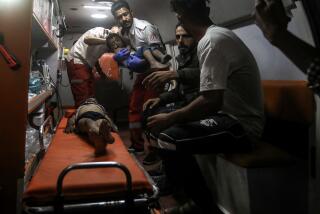Size of N. Korea’s Food Crisis Is Hard to Figure
- Share via
BEIJING — How serious is the food shortage inside North Korea?
International relief organizations, foreign governments and academic experts vary greatly in their assessment of food conditions inside the world’s most isolated regime.
At a recent news conference here, Douglas Coutts, director of U.N. World Food Program operations inside North Korea, said drought and tidal waves severely reduced the autumn grain harvest in the country of more than 20 million people.
“The combination of food shortages, already-existing malnutrition, lack of pharmaceutical supplies and the harshness of winters in North Korea could lead to disastrous consequences,” Coutts said. The country’s rationed grain supplies will probably hold out until March, Coutts said, but after that North Korea will need at least 1 million tons of additional food aid.
However, the U.N. official, who has extensive experience in Africa, said conditions have not yet reached a state of full famine.
“This is not a famine in the classic sense of the word,” Coutts said. “It’s a very slow, gradual, building situation.”
In contrast, refugees from North Korea interviewed across the border in China consistently describe a country that is already in the throes of acute famine, with as many as 1 million deaths and widespread cannibalism.
Testifying before the Senate Committee on Foreign Relations in July, even before the poor fall harvest, Andrew Natsios, vice president of the Christian relief organization World Vision, presented a bleak portrait of conditions, particularly in the northern regions, where few aid workers are allowed to travel.
“I know a famine when I see one,” Natsios said, “and there is a famine in North Korea right now. Thousands of people are dying.”
Getting a clear picture is difficult because of the Communist country’s extreme isolation and because foreign reporters and observers are not permitted access to vast areas of the country.
“North Korea sees itself as being surrounded and has reacted with a kind of siege mentality,” said Kurt M. Campbell, deputy assistant secretary of Defense for East Asian and Pacific affairs.
The North Korean government blames its plight on a series of natural disasters, beginning with serious floods in 1995 and culminating in this year’s drought and coastal storms that damaged dikes and allowed seawater to flood some of the country’s main rice farms.
However, most international experts, including those in China, view the country’s problems as structural and ideological.
“Output was falling well before the floods occurred in 1995,” said Marcus Noland, an expert with the Institute for International Economics in Washington. “North Korea had appealed to Japan and South Korea for aid before the floods occurred. So this is a systemic problem. This is not a problem caused by bad luck.”
More to Read
Sign up for Essential California
The most important California stories and recommendations in your inbox every morning.
You may occasionally receive promotional content from the Los Angeles Times.










